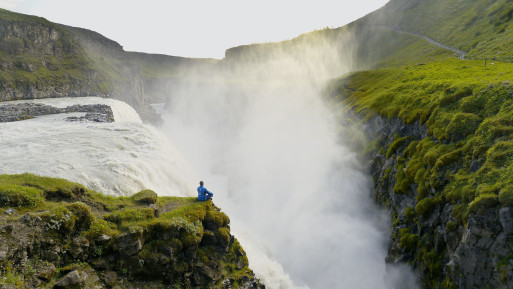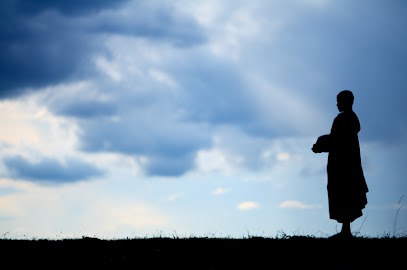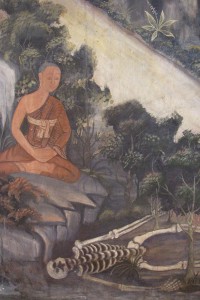
Credit: photoshd.wordpress.com
It may sound macabre or unusual, but corpse mediation is real — and, in many parts of Thailand and some other parts of Southeast Asia, a fairly normal occurrence, specifically among Buddhist monks.
It’s typical for monks to meditate while in the presence of or looking at dead bodies. Sometimes it is a literal body, other times a photo. In fact, many monks actually carry photographs depicting deaths or bodies in various stages of decomposition, and such photographs can be purchased at religious shops throughout Thailand. The Buddha himself even recommended corpse meditation, and it is a widely respected practice.
And yes, to most of us this may sound deeply unpleasant. But corpse mediation serves several important purposes. According to Arthur C. Brooks of The New York Times (who has witnessed corpse meditation first hand), “This mediation of death is intended as a key to better living. It makes disciples aware of the transitory nature of their own physical lives and stimulates a realignment between momentary desires and existential goals. In other words, it makes one ask, ‘Am I making the right use of my scarce and precious life?’”
Siripanyo Bhikkhu — a monk interviewed for a piece in The Washington Times — said that the purpose of this traditional form of meditation is, “simply to hold in your mind, very clearly, that when you look at a [living] person, you’re seeing only the external aspects of that physical person…We are obsessed with the externals. No one wants to see the internals. But we try to see them in an equal light, neither delighting nor being repelled by the attractive or unattractive signs of the external or internal.”
He goes on to explain that it is completely normal for a monk to have corpse meditation photos with them at all times. Often they will take them out when eating, resting or in other situations throughout the day.

Credit: omharmonics.com
“It sounds incredibly gruesome and almost bizarre,” Bhikkhu says, “But it is totally, totally normal and understood in Thailand.”
And perhaps these Buddhist monks are on to something. So often, we try to shove death into the darkest corners of our subconscious. But, in some ways, reminding ourselves of our transience helps us to truly embrace life.

 Corpse Meditation: A Buddhist Practice
Corpse Meditation: A Buddhist Practice



 Our Monthly Tip: Make an “In Case of Death” File to Ease Loved One’s Grief
Our Monthly Tip: Make an “In Case of Death” File to Ease Loved One’s Grief
 Passing of Beloved Comedian Births a New Comedy Festival
Passing of Beloved Comedian Births a New Comedy Festival
















Never heard of this before, meditating in front of a corpse. That’s so creepy.
Report this comment
notjust meditating infront but meditating about the decaying stages. That is what we are , from birth we begin to die. the point is None clinging .
Report this comment
Very true, Susan, The purpose of the meditation is to accept finititude and impermanence.
Report this comment
Maybe you should start to think about it, because rhat is what will happen to you too.
Report this comment
These people are freaks! The religion that worships death. I choose life, I choose Jesus Christ. I can’t believe this is what people are doing with their free time now. This is against Christ, this is Antichrist!
But nobody is 100% positive, without doubt sure of what occurs after death. So who are you to say that these people are freaks? All because they have a different explanation about what occurs once we pass? — at least they are using it to come to reality, instead of completely resisting all other ideas and creating some fairyland in their mind if what death it.
Report this comment
Actually quite similar to ascetic practices in Christianity where monks would often keep skulls as memento mori, make mummies (as seen in Palermo’s Capuchin Catacombs, Rome’s Capuchin Crypts, and many other smaller towns and villages throughout Italy) or build ossuaries of elaborate bone patterns (also Rome’s Capuchin Crypts, Milan’s bone chapel, bone chapels in Portugal, such as in Evora, in Poland, two famous examples in Czechia in Brno and Kutna Hora’s Sedlec Ossuary, and several Orthodox monasteries on Greek islands.
Report this comment
There is also the pretty gruesome Tantra practice of Shaiva Sasha a where a practitioner is supposed to actually sit crosslegged on a fresh corpse. Many Hindu divinities are sometimes depicted this way as well, Kalī being a notable example.
Report this comment
Sorry, autocorrect, should have said Shaiva Sadhana.
Report this comment
I had read this practice when I was a teenage in one Sutra. After many years of meditate, I still
have sexual design arising from time to time. And remember this corpse meditation also help in dissolving this clinging in form. Free from all attachment is the key.
A quick search online led me here, looking for guidance and techniques?
Report this comment